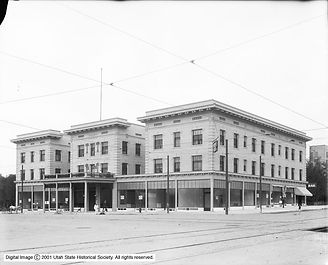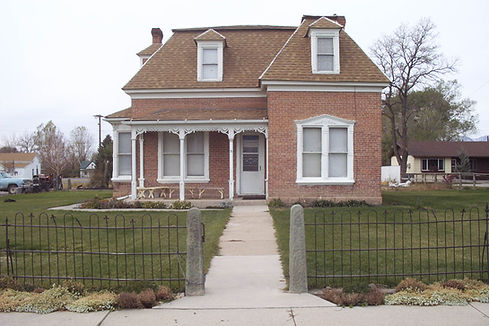Preservation Easements

About
A preservation easement is a legal agreement requiring the easement holder to protect a particular historic structure's visual and structural integrity even though another person owns it. The easement intends to prevent anyone from demolishing or severely altering the historic building without the easement holder's permission.
The owner retains all the usual private property rights except the right to destroy the property. Alterations, improvements, and even additions to the structure are allowed as long as they do not compromise its historic character. At Preservation Utah, we are eager to work with the property owner on which we hold an easement to preserve a building's historic character and make it a comfortable and desirable place to live or work.
Main Players
-
Preservation Utah
-
Historic building and property owners
-
IRS
Why are Easements Important?
Many people who are interested in older buildings are under the false impression that if a building is “historic,” it is somehow automatically protected from destruction. A listing on the National Register of Historic Places does not prevent an owner from demolishing a building. In some cities, local preservation ordinances do provide a measure of protection for historic properties. On the other hand, an easement is a legal document that ensures the preservation of a historic property in perpetuity.


How Can Easements Benefit Property Owners?
Granting a preservation easement can lead to substantial savings for the owner of a historic structure. First, the assessed value of the property may be lowered or stabilized, resulting in property taxes that are lower or at least held to their current rate. Some residential properties may not see much difference, as the easement would not diminish a house's value for use as a home. The savings, however, may be substantial in the case of urban properties that are zoned to allow buildings much larger than the existing historic structure and in the case of rural properties where the easement precludes extensive development.
Second, a property owner who grants an easement to a qualified tax-exempt organization such as Preservation Utah can qualify for an income tax deduction under the charitable contribution clause. Some restrictions apply. As with any tax issue, you should consult your accountant to determine how these easement benefits could affect your financial situation.
Finally, easements that lower a property's assessed value can also reduce taxes on estate, gift, and capital gains. The estate tax savings can be considerable, far outweighing property and income tax benefits and even exceeding the property's value in some cases. These savings will, of course, depend on the particular property in question and the financial situation of the easement donor. As with any tax issue, you should consult your accountant to determine how these easement benefits could affect your financial situation.
What Does a Preservation Easement Cover?
Most of the preservation easements held by Preservation Utah are facade easements that pertain to the exterior envelope of the building. The interior of the building is not usually included in the scope of the easement; however, structural elements are indirectly covered since the exterior of the building obviously cannot be preserved if the structure holding it up is allowed to collapse. Naturally, the easement also prohibits alterations to the surrounding grounds that would mar the exterior appearance of the building, such as rubbish heaps, ash dumps, and utility towers.
Preservation easements may also be applied to land. For example, a farm owner who does not wish to develop his/her land can grant an easement restricting the future development of the property. In some parts of the country, land preservation easements have become an important tool for preserving open space, and conservation groups have used them to protect wildlife habitats.


How do Easements Impact Owners' Use of their Property?
Preservation Utah is happy to work with the owners of buildings on which we hold easements to accommodate their needs and desires to expand or modify their structures. The key to success is to begin the discussion of plans at the conceptual stage so that approval can be agreed upon before any work is started. This way, Preservation Utah can fulfill its duty to ensure that the site's historic integrity will not be compromised. Often, Preservation Utah can provide valuable advice for getting work done right and saving money. Easement property owners should begin the alteration process by reviewing and submitting this form.
As a preservation easement holder, it is Preservation Utah's responsibility to conduct regular inspections of its easement properties to confirm that they are being maintained following the terms of the easements. The inspections also allow Preservation Utah to monitor the condition of a property over time and make recommendations to property owners for maintenance work, which will prevent minor problems from becoming significant problems. Most inspections testify to the dedication and care lavished by owners on their historic properties. In the rare cases where an easement violation has occurred, Preservation Utah is legally empowered to correct the violation at the owner's expense.
For more information about the Preservation Utah Preservation Easement Program, contact our Historic Properties Program Manager at historicproperties@preservationutah.org or (801) 533-0858.
How Long Does an Easement Last?
The length of time that an easement will run is specified in the easement document itself and can be any period agreed upon by the signers of the easement. However, most preservation easements, including the ones held by Preservation Utah, are “granted in perpetuity” and “deemed to run with the land,” meaning that they last forever, no matter how many times or to whom the property is sold. This ensures that the protection offered by the easement will not cease just because a building has a new owner.


How do Easements get Started?
Preservation Utah works with a historic property owner who wants to ensure that the property will not be destroyed or inappropriately altered by subsequent owners to grant a preservation easement on the property. The terms of such an easement can be written in any manner the owner wants as long as they are acceptable to Preservation Utah. An easement is a legal agreement between a property owner and Preservation Utah, a holding organization. It governs the future treatment of the property to ensure it is appropriate for the historic building.
For more information about the Preservation Utah Preservation Easement Program, contact our Historic Properties Program Manager at historicproperties@preservationutah.org or (801) 533-0858.
Pros and Cons
Positives
-
Provides the highest level of protection for a building against demolition or insensitive alteration - reviews and protection administered by Preservation Utah.
-
Easements remain in force in perpetuity.
-
Easements run with the land, which is in force through subsequent ownership.
-
Easements have a consistency of policy—donations to private organizations such as Preservation Utah are not subject to politics, changing administrations, or elected officials.
-
Protecting one building in the middle of a potentially larger development can preserve many buildings around it because several parcels cannot be combined for redevelopment.
Negatives
-
Without prior interest or education about historic preservation, property owners are typically reticent.
-
Cost is the highest for a property owner - costs vary depending on the appraised value of a property.
-
It can be perceived as a barrier to selling a house - though it actually is not.
-
It only protects one building at a time.

